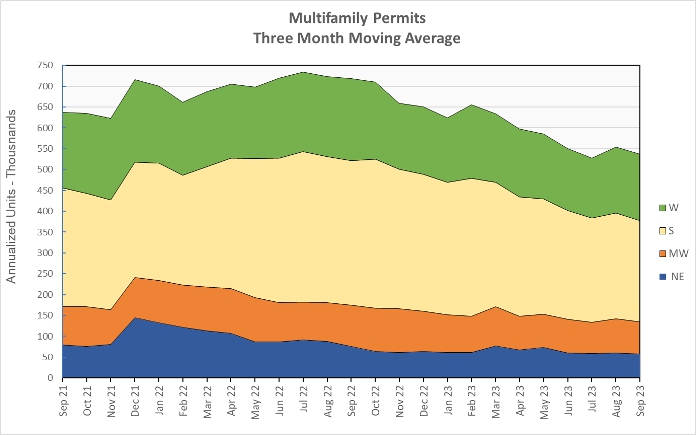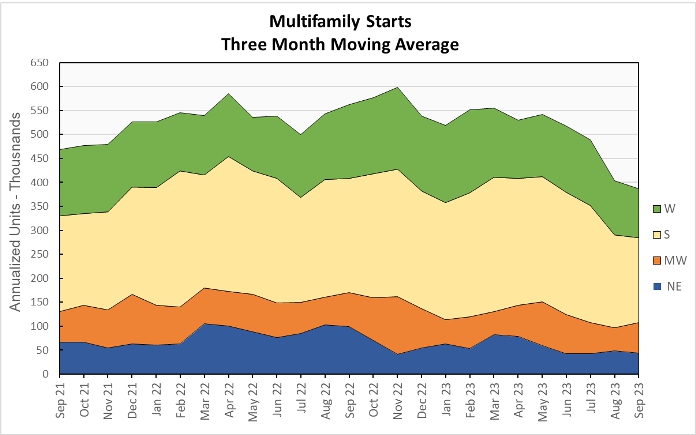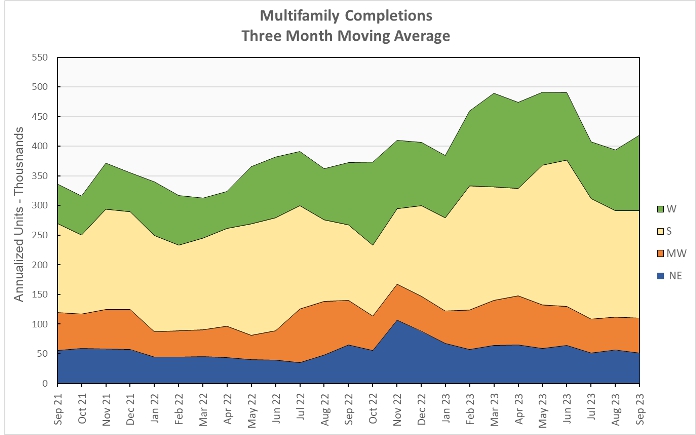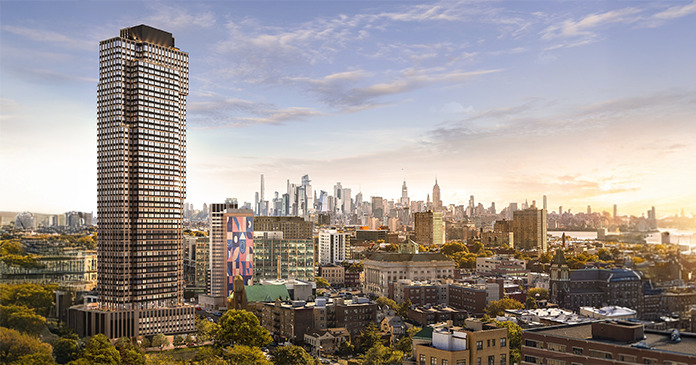The Census Bureau’s new residential construction report for September stated that the number of multifamily construction starts and unit completions were up from the levels reported last month. However, the number of multifamily permits issued fell, possibly indicating lower construction activity in the coming months. Permits, starts and completions all saw double digit percentage changes from the levels of the month before.
The number of multifamily units under construction fell for the second month in a row after a long string of gains.
The report on single-family housing construction showed that, on a seasonally adjusted basis, single family permits rose 1.8 percent, starts rose 3.2 percent, while completions rose 5.3 percent. The reported number of single-family units under construction fell 5,000 from the revised level of the month before to 674,000 units.
Multifamily housing permits plunge
The number of permits issued for buildings with 5 or more units in September was reported to be 459,000 units on a seasonally adjusted, annualized basis. This was down 14.0 percent (75,000 units) from August’s revised (-1,000 units) figure, more than reversing last month’s gain. September permits were down 31.6 percent from the level recorded in September 2022 and were also down 18.3 percent from the trailing 12-month average.
In addition, 49,000 permits were issued in September for units in buildings with 2 to 4 units. This was down 10,000 units from the unchanged figure for August. September permits for units in buildings with 2 to 4 units were down 5.8 percent from the year-ago level and were down 7.3 percent from the trailing 12-month average.
Regional data for multifamily housing is only reported for structures with two or more units. “Structures with 5 or more units” is not broken out as a separate category. Since the regional data is highly volatile and is frequently revised, it is examined here based on three-month weighted moving averages. This averaging helps smooth out the month-to-month variations in the data.
Nationally, the three-month weighted moving average for permits issued for multifamily housing in September was down 3.0 percent from the level in August and was down 25.2 percent from the level of September 2022. The three-month weighted moving average for permits came it at 537,000 annualized units.
On a month-over-month basis, the three-month weighted moving average for multifamily permit issuance was up only in the West region. Permit issuance rose 1.1 percent in the West but fell 4.4 percent in both the Northeast and the South and 5.3 percent in the Midwest.
When compared to year-earlier levels, the three-month weighted moving average of permits issued was down 29.9 percent in the South, 23.8 percent in the Northeast, 22.6 percent in the Midwest and 19.0 percent in the West.
The following chart shows the three-month weighted moving averages of permits by region for the last 25 months.

Multifamily housing construction starts higher
The preliminary September figure for multifamily housing starts in buildings with 5 or more units was 383,000 units on a seasonally adjusted, annualized basis. This was reported to be up 56,000 units from the revised (-7,000 units) figure for August.
Compared to the year-earlier level, multifamily housing starts in buildings with 5 or more units were down 31.5 percent. The reported starts figure was 24.7 percent lower than the trailing 12-month average but was only 1.6 percent lower than the monthly average from 2019.
Multifamily housing construction starts (two or more units per building) in September were down 4.2 percent from their August level for the country as-a-whole, based on three-month weighted moving averages. Starts were up 32.8 percent in the Midwest but starts fell 8.4 percent in the South, 10.1 percent in the West and 10.7 percent in the Northeast from the levels of the month before.
The three-month weighted moving average of starts was down 31.2 percent for the country-as-a-whole on a year-over-year basis. Compared to September 2022, starts were down 56.2 percent in the Northeast, 33.6 percent in the West, 25.6 percent in the South, and 10.3 percent in the Midwest.
The following chart shows the three-month weighted moving average of starts by region for the last 25 months.

Multifamily housing completions also higher
The preliminary September multifamily housing unit completions figure in buildings with 5 or more units per building was 445,000 units on a seasonally adjusted, annualized basis. This was reported to be up 10.1 percent (41,000 units) from August’s revised (-29,000 units) figure.
Compared to the year-earlier level, multifamily housing completions in buildings with 5 or more units per building were up 15 percent. Compared to the trailing 12-month average, completions were up 5.9 percent and compared to the monthly average for 2019, completions were up 28.1 percent.
For the country as-a-whole, multifamily housing construction completions (two or more units per building) were up 6.4 percent month-over-month, comparing three-month weighted moving averages. The three-month weighted moving average of completions was up 24.7 percent in the West, 6.0 percent in the Midwest and 0.7 percent in the South. However, completions fell 8.6 percent in the Northeast.
On a year-over-year basis, the three-month weighted moving average of completions in buildings with 2 or more units per building was up 12.5 percent nationally. Completions were up 43.1 percent in the South and 21.1 percent in the West. Completions fell 21.2 percent in the Northeast and 21.7 percent in the Midwest.
The three-month weighted moving average of completions by region for the past 25 months are shown in the chart below.

The number of multifamily units reported to be under construction fell again in September. Census reported that there were 986,000 units under construction in buildings with 5 or more units per building on a seasonally adjusted annualized basis. This was reported to be down by 7,000 units from the revised (-2,000 units) level of the month before. It is 10.9 percent, or 97,000 units, higher than the number of units under construction one year earlier.
All data quoted are based on seasonally adjusted results and are subject to revision.











